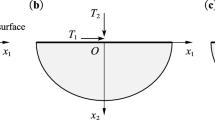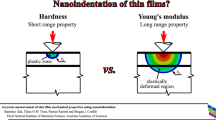Abstract
In this work we derive systems of coupled thin-film equations for immiscible liquid polymer layers on a solid substrate. We take into account slip between liquids and solids and also slip between both liquids. On the scale of tens of nanometres, such two-layer systems are susceptible to instability and may rupture and dewet due to intermolecular forces. The stability of the two-layer system and its significant dependence on the order of magnitude of slip is investigated via these thin-film models. With weak slip at both the liquid–liquid and liquid–solid interfaces and polymer layers of comparable thickness, the dispersion relation typically shows two local maxima, one in the long-wave regime and the other at moderate wavenumbers. The former is associated with perturbations that mainly affect the gas–liquid interface and the latter with larger relative perturbation amplitudes at the liquid–liquid interface. Increasing the slip at the liquid–liquid interface generally favours the long-wave regime and can in fact revert the mode of the instability and thus significantly change the spinodal patterns. Moreover, the maxima shift to small wavenumbers for increasing slip.








Similar content being viewed by others
References
Brochard Wyart F, Martin P, Redon C (1993) Liquid/liquid dewetting. Langmuir 9:3682–3690
Pototsky A, Bestehorn M, Merkt D, Thiele U (2004) Alternative pathways of dewetting for a thin liquid two-layer film. Phys Rev E 70(2):25201
Pototsky A, Bestehorn M, Merkt D, Thiele U (2005) Morphology changes in the evolution of liquid two-layer films. J Chem Phys 122:224711
Fisher L, Golovin A (2005) Nonlinear stability analysis of a two-layer thin liquid film: dewetting and autophobic behavior. J Colloid Interface Sci 291:515–528
Fisher L, Golovin A (2007) Instability of a two-layer thin liquid film with surfactants: dewetting waves. J Colloid Interface Sci 307:203–214
Bandyopadhyay D, Gulabani R, Sharma A (2005) Instability and dynamics of thin liquid bilayers. Ind Eng Chem Res 44:1259–1272
Bandyopadhyay D, Sharma A (2006) Nonlinear instabilities and pathways of rupture in thin liquid bilayers. J Chem Phys 125:054711
Craster RV, Matar O (2006) On the dynamics of liquid lenses. J Colloid Interface Sci 303:503–506
Lenz RD, Kumar S (2007) Competitive displacement of thin liquid films on chemically patterned substrates. J Fluid Mech 571:33–57
Lenz RD, Kumar S (2007) Instability of confined thin liquid film trilayers. J Colloid Interface Sci 316:660–670
Thiele U, Archer AJ, Plapp M (2012) Thermodynamically consistent description of the hydrodynamics of free surfaces covered by insoluble surfactants of high concentration. Phys Fluids 24:102107
Craster RV, Matar O (2009) Dynamics and stability of thin liquid films. Rev Mod Phys 81:1131–1198
Lin CC (1979) A mathematical model for viscosity in capillary extrusion of two-component polyblends. Polym J (Tokyo) 11:185–192
Zhao R, Macosko C (2002) Slip at polymer–polymer interfaces: rheological measurements on coextruded multilayers. J Rheol 46:145–167
Zeng H, Tian Y, Zhao B, Tirrell M, Israelachvili J (2009) Friction at the liquid/liquid interface of two immiscible polymer films. Langmuir 124–132
Lin Z, Kerle T, Russell T, Schaffer E, Steiner U (2002) Electric field induced dewetting at polymer/polymer interfaces. Macromolecules 35:6255–6262
Brochard-Wyart F, de Gennes P (1992) Shear-dependent slippage at a polymer/solid interface. Langmuir 8:3033–3037
Léger L (2003) Friction mechanisms and interfacial slip at fluid–solid interfaces. J Phys Condens Matter 15:S19–S29
Lauga E, Brenner MP, Stone H (2007) Microfluidics: the no-slip boundary condition. In: Tropea C, Yarin A, Foss JF (eds) Handbook of experimental fluid dynamics. Springer, New York, pp 1219–1240
Kargupta K, Sharma A, Khanna R (2004) Instability, dynamics and morphology of thin slipping films. Langmuir 20:244–253
Münch A, Wagner B, Witelski TP (2006) Lubrication models with small to large slip lengths. J Eng Math 53:359–383
Fetzer R, Jacobs K, Münch A, Wagner B, Witelski TP (2005) New slip regimes and the shape of dewetting thin liquid films. Phys Rev Lett 95:127801
Blossey R, Münch A, Rauscher M, Wagner B (2006) Slip vs viscoelasticity in dewetting thin films. EPhJ E Soft Matter 20:267–271
Vilmin T, Raphael E (2005) Dewetting of thin viscoelastic polymer films on slippery substrates. Europhys Lett 72:781
Fetzer R, Münch A, Wagner B, Rauscher M, Jacobs K (2007) Quantifying hydrodynamic slip: a comprehensive analysis of dewetting profiles. Langmuir 23:10559–10566
Bäumchen O, Fetzer R, Jacobs K (2009) Reduced interfacial entanglement density affects the boundary conditions of polymer flow. Phys Rev Lett 103:247801
Goveas J, Fredrickson G (1998) Apparent slip at a polymer–polymer interface. Eur Phys J B Condens Matter Complex Syst 2:79–92
Adhikari NP, Goveas JL (2004) Effects of slip on the viscosity of polymer melts. J Polym Sci B Polym Phys 42:1888–1904
Brochard-Wyart F, de Gennes P (1993) Sliding molecules at a polymer/polymer interface. C R Acad Sci Ser II(327):13–17
Ajdari A (1993) Slippage at a polymer/polymer interface: entanglements and associated friction. C R Acad Sci Ser II 317:1159–1163
Ajdari A, Wyart FB, de Gennes PG, Leibler L, Viovy J, Rubinstein M (1994) Slippage of an entangled polymer melt on a grafted surface. Physica A 204:17–39
Israelachvili JN (1992) Intermolecular and surface forces. Academic, London
Sharma A (1993) Relationship of thin-film stability and morphology to macroscopic parameters of wetting in the apolar and polar sytems. Langmuir 9:861–869
Bonn D, Eggers J, Indekeu J, Meunier J, Rolley E (2011) Wetting and spreading. Rev Mod Phys 81:739–805
Rauscher M, Blossey R, Münch A, Wagner B (2008) Spinodal dewetting of thin films with large interfacial slip: implications from the dispersion relation. Langmuir 24:12290–12294
Bommer S, Jachalski S, Peschka D, Seemann R, Wagner N (2013) Droplets on liquids and their long way into equilibrium. arXiv, preprint arXiv:1212.1183
Ward MH (2011) Interfacial thin films rupture and self-similarity. Phys Fluids 23:062105–062105-14
Witelski TP, Bernoff AJ (1999) Stability of self-similar solutions for Van der Waals driven thin film rupture. Phys Fluids 11:2443–2445
Renardy M (2001) Finite time breakup of viscous filaments. Z Angew Math Phys 52:881–887
Peschka D, Münch A, Niethammer B (2010) Thin-film rupture for large slip. J Eng Math 66:33–51
Peschka D, Niethammer B, Münch A (2010) Self-similar rupture of viscous thin films in the strong-slip regime. Nonlinearity 23:409–427
Acknowledgments
The authors SJ, DP and BW are grateful for the support by the DFG of their project within the priority programme SPP 1506, ‘Transport at Fluidic Interfaces’.
Author information
Authors and Affiliations
Corresponding author
Appendices
Appendix 1: Derivation of thin-film model for strong slip at liquid–liquid and solid–liquid interfaces
We expand the variables in (2.12) as
and consider in turn the leading- and next-order problem in \(\varepsilon _{\ell }\).
1.1 Leading-order problem
For the boundary condition at the free surface \(z={h_2^{(0)}}\) we get for the normal, tangential and kinematic conditions, respectively,
For the boundary condition at the free liquid–liquid interface \(z={h_1^{(0)}}\) we get for the normal, tangential and kinematic conditions, respectively,
The impermeability condition at \(z={h_1^{(0)}}\) between the two liquid layers is given by
The slip condition at the liquid–liquid interface \(z={h_1^{(0)}}\) is
For the boundary conditions at the substrate we assume impermeability and no slip:
From (6.2d), (6.2p) and (6.2a), (6.2h) we conclude
and thus the horizontal velocity components are independent of \(z\). Using this in (6.2f), (6.2o) and (6.2c), (6.2m) we find
Using (6.2e), (6.2j) and (6.2b), (6.2g) we find
hence also independent of \(z\).
1.2 Next-order problem
To close the problem to leading order and determine an equation for \({u_1^{(0)}}\) and \({u_2^{(0)}}\), we need to consider the problem to next order. We will formulate here only the equations that are required to accomplish the task of fixing these leading-order velocity components.
The next-order upper and lower layer equations in the bulk are
The next-order tangential stress boundary conditions at liquid–gas interface \(z={h_2^{(0)}}\) are
At the liquid–liquid interface \(z={h_1^{(0)}}\) we have
and at the solid substrate \(z=0\),
In the preceding equations, we have already made use of the fact that \({u_1^{(0)}}\) and \({u_2^{(0)}}\) do not depend on \(z\) and dropped all derivatives of these variables with respect to \(z\).
Integrating now (6.6a) and (6.6d), we obtain
The pressure terms on the right-hand side can be eliminated by using (6.5a) and (6.5b). The terms on the left-hand side can be expressed in terms of the leading-order solutions \({u_2^{(0)}}\), \({u_2^{(0)}}\), \({h_1^{(0)}}\) and \({h_2^{(0)}}\) by first using (6.6g), (6.6h), (6.6i) and (6.6j), then eliminating the occurring \({w_2^{(0)}}\) and \({w_1^{(0)}}\) via the solutions (6.4a) and (6.4b). This yields Eqs. (3.8a) and (3.8c). The other two equations, (3.8b) and (3.8d), are obtained by integrating (6.2c) and (6.2f) and using the conditions (6.2i), (6.2l), (6.2m), (6.2p).
Appendix 2: Dispersion relations for Stokes equations
We start the stability analysis with the Stokes equations
and the boundary conditions from the previous sections. To simplify our problem, we introduce the stream functions \(\Psi _1\) and \(\Psi _2\) with
Plugging this into the Stokes equations we obtain two biharmonic equations:
Linear stability is carried out by introducing small perturbations
around the base state
where \(\omega \) and \(k\) are the growth coefficient and the wavenumber, and obtain
with the general solutions
where the coefficients are determined using the boundary conditions. First, slip at \(z=0\) leads to
while impermeability simply reads
At the free surface \(z=h_2\) the kinematic condition becomes
the tangential stress condition
At the liquid–liquid interface \(z=h_1\), the kinematic condition now reads
the tangential stress condition
The impermeability condition is equivalent to
and, finally, the slip condition
where \(b_*=(1+\mu _2/\mu _1){b_1}\). For the solution of this algebraic system we use the remaining boundary conditions, namely the normal stress conditions at \(z=h_2\)
and at \(z=h_1\)
Rights and permissions
About this article
Cite this article
Jachalski, S., Peschka, D., Münch, A. et al. Impact of interfacial slip on the stability of liquid two-layer polymer films. J Eng Math 86, 9–29 (2014). https://doi.org/10.1007/s10665-013-9651-8
Received:
Accepted:
Published:
Issue Date:
DOI: https://doi.org/10.1007/s10665-013-9651-8




